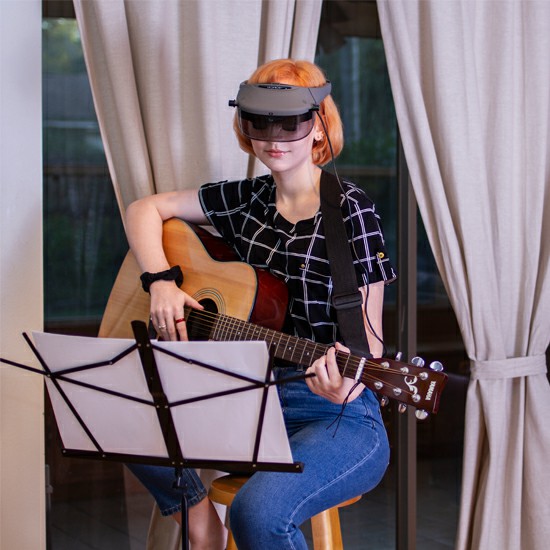In a world dominated by visual experiences, the challenges faced by individuals with low vision are often underestimated. Low vision caused by various eye conditions leads to severe visual impairments that cannot be fully corrected or cured by traditional eyewear or treatments. In this case, electronic magnifiers become a trend to enrich the life of visually impaired people and bring them more benefits and convenience. This article talks about the transformative role of electronic magnifiers in helping low vision individuals, enhancing their independence, and improving their quality of life.
About Low Vision
Low vision is typically defined based on visual acuity and the extent of the field of vision. A common way to describe low vision is having a visual acuity of 20/70 or worse in the better eye, even with the corrective lenses. Another criterion is having a restricted field of vision, which means the peripheral vision of individuals is limited or missing. This impairment can greatly impact people’s ability to read, drive, recognize faces, watch television, or perform other tasks that require clear and detailed vision.
 Unlike blindness, where individuals have little to no usable vision, people with low vision retain some degree of functional vision, albeit with limitations. Unlike blindness, people with low vision maintain some functional vision, but with limits. They may experience a range of visual challenges, including blurred or distorted vision, sensitivity to light, difficulty distinguishing colors, and challenges with depth perception. These visual limitations can significantly affect their independence, confidence, and overall quality of life, making everyday activities more challenging and potentially leading to social isolation.
Unlike blindness, where individuals have little to no usable vision, people with low vision retain some degree of functional vision, albeit with limitations. Unlike blindness, people with low vision maintain some functional vision, but with limits. They may experience a range of visual challenges, including blurred or distorted vision, sensitivity to light, difficulty distinguishing colors, and challenges with depth perception. These visual limitations can significantly affect their independence, confidence, and overall quality of life, making everyday activities more challenging and potentially leading to social isolation.
Low vision is actually a common phenomenon in our daily life, and it’s usually caused by a series of eye diseases such as glaucoma, cataracts, age-related macular degeneration, diabetic retinopathy or so. These eye diseases vary in their causes, symptoms, and impact on vision. They are usually irreversible and cannot be cured, and they can also probably lead to 20/200 vision when they’re getting worse. Low vision caused by these eye disorders can have serious consequences. However, the advancements in assistive technologies, particularly electronic magnifiers, have opened up new opportunities for improving the lives of persons with low vision.
Assistive Technology for Low Vision
Modern technology supports experts to innovate more and more assistive technology for low vision people. For instance, common visual assistive devices may include magnifying apps that can be downloaded onto your smartphone or tablet, allowing you to enlarge images and text using the device’s camera; traditional optical magnifiers that are convenient for reading books and labels; screen readers that convert text into speech or Braille; and electronic video magnifiers, which combine multiple functions and demonstrate images with high-quality on its own display.
 However, traditional visual aids somehow have limitations when it comes to assisting those with limited vision. Traditional handheld magnifiers, for example, can only be able to magnify text or images, are lack further helpful capabilities. Similarly, some magnification mobile apps are convenient but relatively basic in functionality, usually providing only simple image magnification and contrast adjustment. These traditional tools lack adaptability to different daily tasks and cannot meet more complex needs, limiting the independence of low vision individuals in the diverse environments. If you would like to know more about magnifying apps and video magnifiers, go check: Can Video Magnifiers be Replaced by Magnifying APPs?
However, traditional visual aids somehow have limitations when it comes to assisting those with limited vision. Traditional handheld magnifiers, for example, can only be able to magnify text or images, are lack further helpful capabilities. Similarly, some magnification mobile apps are convenient but relatively basic in functionality, usually providing only simple image magnification and contrast adjustment. These traditional tools lack adaptability to different daily tasks and cannot meet more complex needs, limiting the independence of low vision individuals in the diverse environments. If you would like to know more about magnifying apps and video magnifiers, go check: Can Video Magnifiers be Replaced by Magnifying APPs?
The prevalence of electronic video magnifiers is to make up for the shortcomings of these traditional equipment and bring more possibilities to people with low vision. In fact, whether through traditional magnification devices or electronic magnifiers, the ultimate goal is to assist visually impaired people and enhance their quality of life. From the adjustable magnification of images and text through smartphone apps to the portability of traditional handheld magnifiers and the revolutionary electronic video magnifiers, all these tools mean to promote independence and make it more accessible for those with low vision in daily tasks.

How Electronic Magnifiers Help?
Unlike traditional visual aids, electronic video magnifiers have a dynamic and versatile approach to magnification or color contrasts. These features allow people who have visual impairments to engage in a wide range of tasks, from reading documents to enjoying hobbies or exploring the visual world around them. Furthermore, electronic video magnifiers always can provide a comfortable and amazing viewing experience. Their high-resolution displays ensure clarity and sharpness, reducing eye strain and fatigue often associated with traditional magnifiers. This is particularly beneficial for long-term reading sessions or engaging in activities that require sustained visual focus.
Another reason to choose electronic video magnifiers is their adaptability to modern technology. Many of these devices offer memory options, allowing users to capture images, store them digitally, and share them with others. This is what Zoomax Snow 12 can do, capturing and saving pictures up to 1000, transferring them to your own computer, and even applying OCR/text-to-speech function to read your text in various languages loudly.
 Moreover, the different types of electronic magnifiers perform various advantages to the daily life of low vision people. For example, the portable electronic video magnifiers can attract people with low vision due to their portability. The lightweight of the device make them can be easily carried and used in various settings, both indoors and outdoors. This mobility fosters integration into daily routines, ensuring that people with visual impairments have the tools they need wherever they go.
Moreover, the different types of electronic magnifiers perform various advantages to the daily life of low vision people. For example, the portable electronic video magnifiers can attract people with low vision due to their portability. The lightweight of the device make them can be easily carried and used in various settings, both indoors and outdoors. This mobility fosters integration into daily routines, ensuring that people with visual impairments have the tools they need wherever they go.
Other types of electronic video magnifiers also find practical applications in various aspects of daily life, providing convenience and autonomy for people with low vision. To be more specific in life scenes, the handheld electronic video magnifiers can be particularly useful for outdoor use, offering portability that allows users to easily carry everywhere. While eating in a restaurant, for instance, visually impaired people can effortlessly use handheld electronic video magnifiers to read menus. Or in a supermarket, they can examine product labels to make right choices during shopping. For example, Zoomax Luna 6 and Acesight AR or Acesight S are helpful when you do shopping.
For learning or work, portable or desktop electronic video magnifiers play a crucial role. These devices often come equipped with advanced features, adapting to more complex needs. In school or the workplace, electronic magnifiers enable low vision people to read textbooks, notes, and documents, promoting learning engagement and productivity. In addition, electronic video magnifiers unlock more possibilities for hobbies and entertainment. Whether appreciating artwork, reading sheet music, or participating in handcraft activities, these devices provide a gateway to a world of visual exploration, thanks to their high-definition displays and multifunctional capabilities.

In some circumstances, electronic video magnifiers are considered as transformative tools, bridging the gap between low vision individuals and the visual world. By addressing the challenges created by common eye conditions, these devices enhance independence, improve the quality of life, and pave the way for educational and vocational growth. As technology advances, the future is ensuring that low vision people can navigate the world with increased confidence and participate fully in all aspects of life. In summary, electronic video magnifiers have a profound impact across various domains of life, offering more and more opportunities and convenience to people who are visually impaired.

